October 21, 2024 · 8 min read
How to Use Data from Project Meetings to Drive Strategic Decisions

Shaimaa Badawi
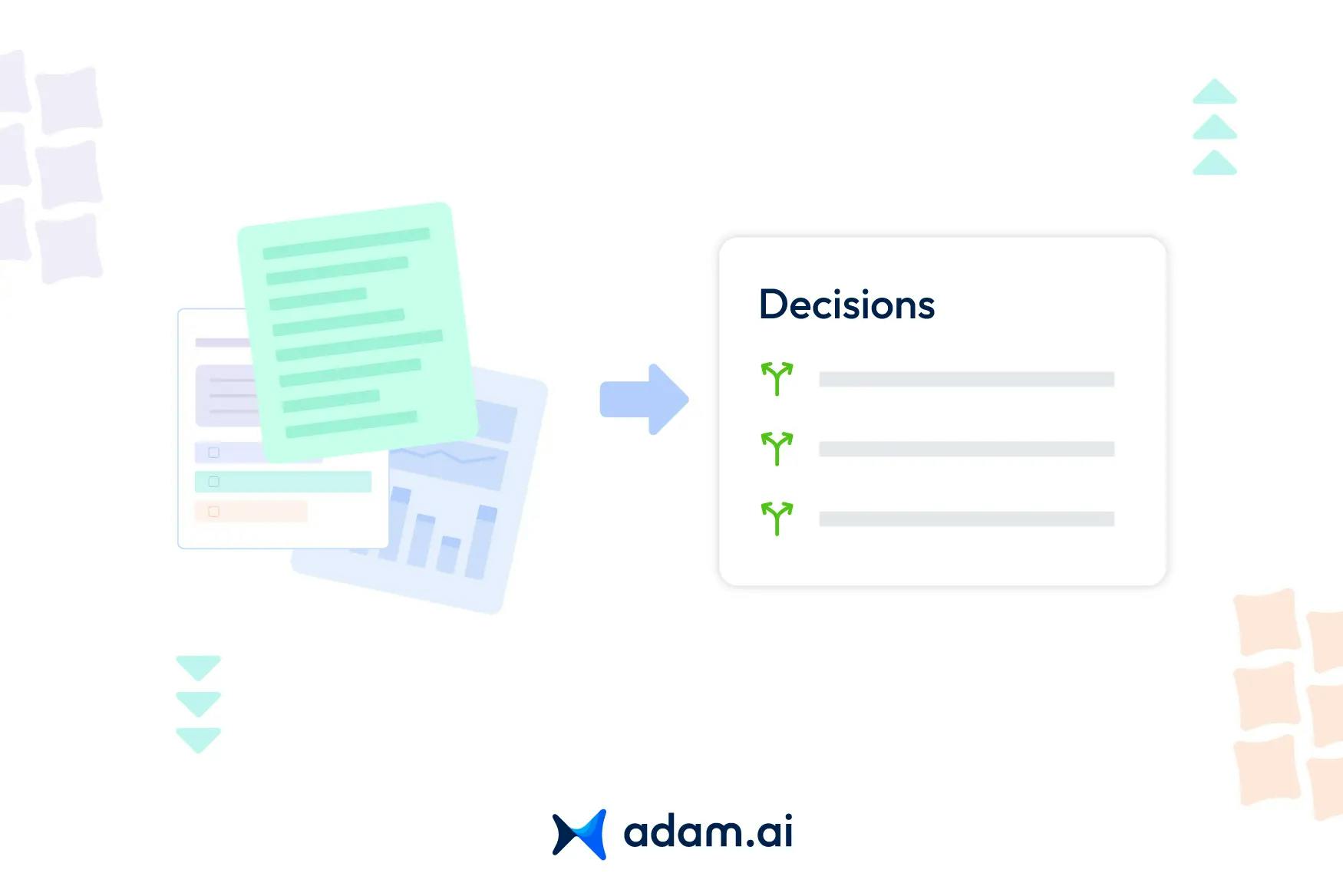
Behind every successful project is a manager who knows how to turn meeting data into actionable insights. Strategic use of meeting analytics can uncover insights that drive results, streamline workflows, and maximize ROI. This article covers how to turn raw meeting data into meaningful actions, tackle common challenges project managers face, and use data to enhance decision-making and project outcomes.
What does data-driven decision-making mean for project managers?
Data-driven decision-making (DDDM) empowers project managers to make informed choices by analyzing and interpreting factual data rather than relying on intuition or assumptions. It involves transforming raw information into actionable insights that guide project strategies and actions.
Key elements of DDDM for project managers:
- Data collection: Gathering relevant data from sources like meeting minutes, action items, and project updates.
- Analysis and interpretation: Identifying trends, patterns, and gaps through analytics tools to evaluate project progress.
- Bias reduction: Using evidence-based decisions to minimize subjective influences.
- Strategic alignment: Ensuring that decisions are aligned with organizational goals and key performance indicators (KPIs).
Why is meeting data critical for strategic project decisions?
Data from project meetings serves as a cornerstone for strategic decision-making, providing clarity, accountability, and actionable insights. Here's why it is essential:
1. Ensures informed decision-making
Meeting data, such as task updates, action items, and discussion summaries, eliminates guesswork by offering concrete evidence for planning and prioritization. This leads to more accurate and effective strategies.
2. Drives accountability
Tracking meeting data ensures that action items are assigned, monitored, and completed. Accountability fosters a results-driven environment where project goals are consistently met.
3. Identifies trends and bottlenecks
Analytics from meeting data, like recurring delays or unresolved issues, help project managers identify patterns. This allows for proactive adjustments to workflows and resource allocation.
4. Enhances stakeholder communication
Centralized meeting records ensure transparency and alignment among team members and stakeholders, reducing miscommunication and improving trust.
5. Facilitates continuous improvement
Analyzing meeting outcomes over time allows teams to refine processes, ensuring better planning, execution, and overall project outcomes.
How can meeting analytics help project managers uncover actionable insights?
Meeting analytics transforms raw data into meaningful insights that empower project managers to make informed decisions and optimize project outcomes. Here's how:
1. Tracking key metrics
Meeting analytics provide measurable data on attendance, engagement, task completion rates, and recurring action items. For instance, tracking the percentage of completed tasks assigned during meetings highlights productivity trends.
2. Identifying bottlenecks
Analytics pinpoint recurring challenges such as delayed action items or unresolved decisions, allowing managers to address root causes proactively and streamline workflows.
3. Prioritizing actions
By analyzing the outcomes of past meetings, project managers can prioritize high-impact tasks, ensuring resources are directed toward the most critical objectives.
4. Enhancing decision-making
Visualized data like charts or dashboards help managers identify patterns and correlations, such as how specific discussion topics affect project milestones or team performance.
5. Driving strategic adjustments
Real-time insights from meeting analytics enable managers to adjust strategies dynamically, ensuring projects stay aligned with timelines and goals.
What types of data should project managers focus on during and after meetings?
Project managers should focus on collecting and analyzing data that directly impacts project progress, accountability, and outcomes. This can be categorized as follows:
1. Action-oriented data
- Action items: Tasks assigned, their owners, deadlines, and status updates.
- Decisions made: Key agreements that influence project direction or resource allocation.
2. Performance metrics
- Completion rates: Percentage of completed tasks versus assigned tasks.
- Follow-up effectiveness: Timeliness and quality of responses to assigned action items.
3. Attendance and participation
- Attendance records: Tracking who attended and who missed key discussions.
- Engagement levels: Noting active participation and contributions during meetings.
4. Discussion insights
- Recurring topics: Identifying themes that need strategic focus.
- Challenges highlighted: Issues or risks raised during the meeting.
5. Meeting efficiency metrics
- Duration and timing: Comparing scheduled versus actual meeting duration.
- Agenda adherence: Tracking how well the meeting sticks to planned topics.
6. Outcome data
- Post-meeting deliverables: Progress on tasks and initiatives discussed in the meeting.
- Stakeholder feedback: Insights from team members or stakeholders on meeting effectiveness.
How do data-driven decisions improve project outcomes and ROI?
Data-driven decisions enhance project outcomes and ROI by optimizing resources, streamlining workflows, and ensuring strategic alignment. Here's how:
1. Enhanced accuracy in planning
Analyzing past project data helps identify realistic timelines, resource needs, and potential risks. This accuracy reduces wasted effort and aligns project objectives with achievable goals.
2. Improved resource allocation
Data insights ensure that resources, whether human, financial, or material, are allocated where they have the most impact. For example, focusing on high-priority tasks improves efficiency and minimizes resource wastage.
3. Proactive risk mitigation
By identifying patterns and anomalies, data-driven decisions enable project managers to anticipate risks and implement mitigation strategies before they escalate, safeguarding the project’s success.
4. Increased team productivity
Data highlights bottlenecks and inefficiencies, allowing managers to refine processes and boost team performance. Clear metrics also enhance accountability and motivation within the team.
5. Maximized ROI
Focusing on actionable insights derived from meeting data ensures that every decision contributes to the project’s goals, leading to better outcomes. For example, tracking task completion rates helps prioritize efforts that directly impact ROI.
6. Continuous improvement
Analyzing meeting data fosters a culture of learning, where teams use insights from past performance to optimize future strategies, increasing long-term success.
What challenges do project managers face in utilizing meeting data effectively?
Project managers encounter several challenges when leveraging meeting data effectively. These obstacles often stem from data management, accessibility, and interpretation issues:
- Data fragmentation across platforms: Meeting data is often stored in different tools or formats, making it difficult to consolidate and analyze comprehensively.
- Lack of real-time access: Delays in updating or accessing meeting data can hinder timely decision-making and disrupt project workflows.
- Poor data quality: Inaccurate, incomplete, or outdated meeting records can lead to flawed insights and misinformed decisions.
- Insufficient analytical skills: Many teams lack the expertise to interpret meeting data effectively, resulting in missed opportunities for actionable insights.
- Limited integration with other systems: The inability to integrate meeting data with project management or analytics tools limits its utility in broader decision-making processes.
- Resistance to adopting data-driven practices: Team members may rely on intuition or experience rather than using data, creating a barrier to leveraging meeting insights.
How can a meeting management platform simplify the use of data for strategic decisions?
A meeting management platform simplifies the process of using data for strategic decisions by centralizing, organizing, and making insights easily accessible. Here's how:
- Centralized data storage: It consolidates meeting agendas, minutes, action items, and decisions in one platform, eliminating data fragmentation and enhancing accessibility.
- Real-time updates: The platform ensures that all meeting data is updated in real time, allowing project managers to make timely and informed decisions.
- Integrated analytics tools: Built-in analytics features highlight patterns, trends, and insights, enabling managers to uncover actionable data without requiring advanced technical skills.
- Enhanced collaboration: The platform facilitates team input and feedback by enabling easy sharing of data, decisions, and reports with relevant stakeholders.
- Automation of follow-ups: It automates tasks like sending reminders, tracking deadlines, and generating reports, reducing manual work and ensuring accountability.
- Customizable dashboards: Visualized insights through dashboards make data easier to interpret, helping managers focus on strategic priorities and adjust plans effectively.
Why is adam.ai the ideal choice for leveraging meeting analytics in projects?
adam.ai is an intelligent meeting management platform that empowers project managers to leverage meeting analytics effectively, driving strategic decisions and enhancing project outcomes. Here's how its key features contribute:
1. Comprehensive agenda planning: adam.ai offers customizable agenda templates, enabling project managers to structure meetings with clear objectives and assigned time slots.
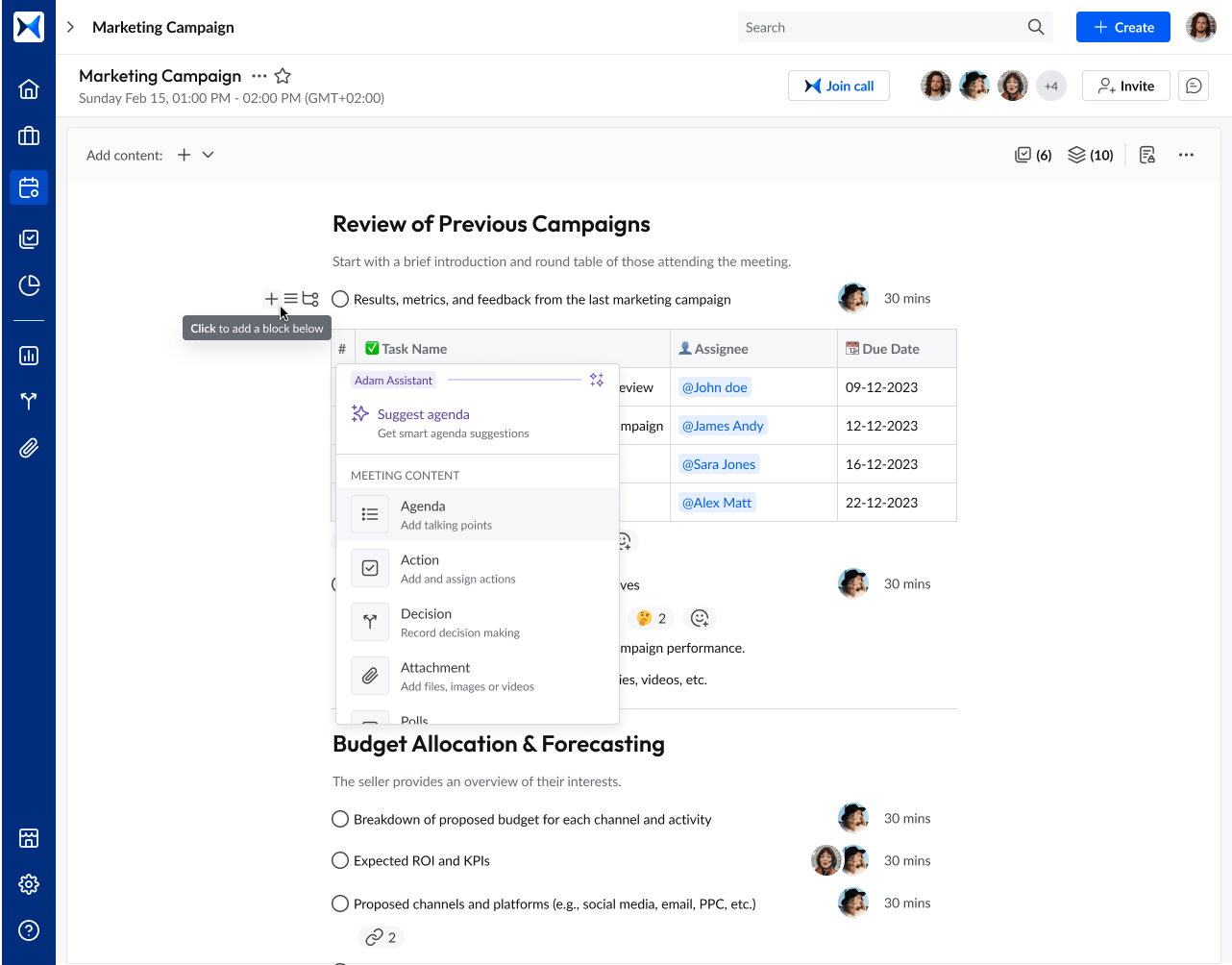
2. Real-time content collaboration The platform facilitates live annotation of documents and presentations, allowing team members to engage actively during meetings. Features like comments, mentions, and emoji reactions foster a collaborative environment, ensuring that every voice is heard and every detail is noted.
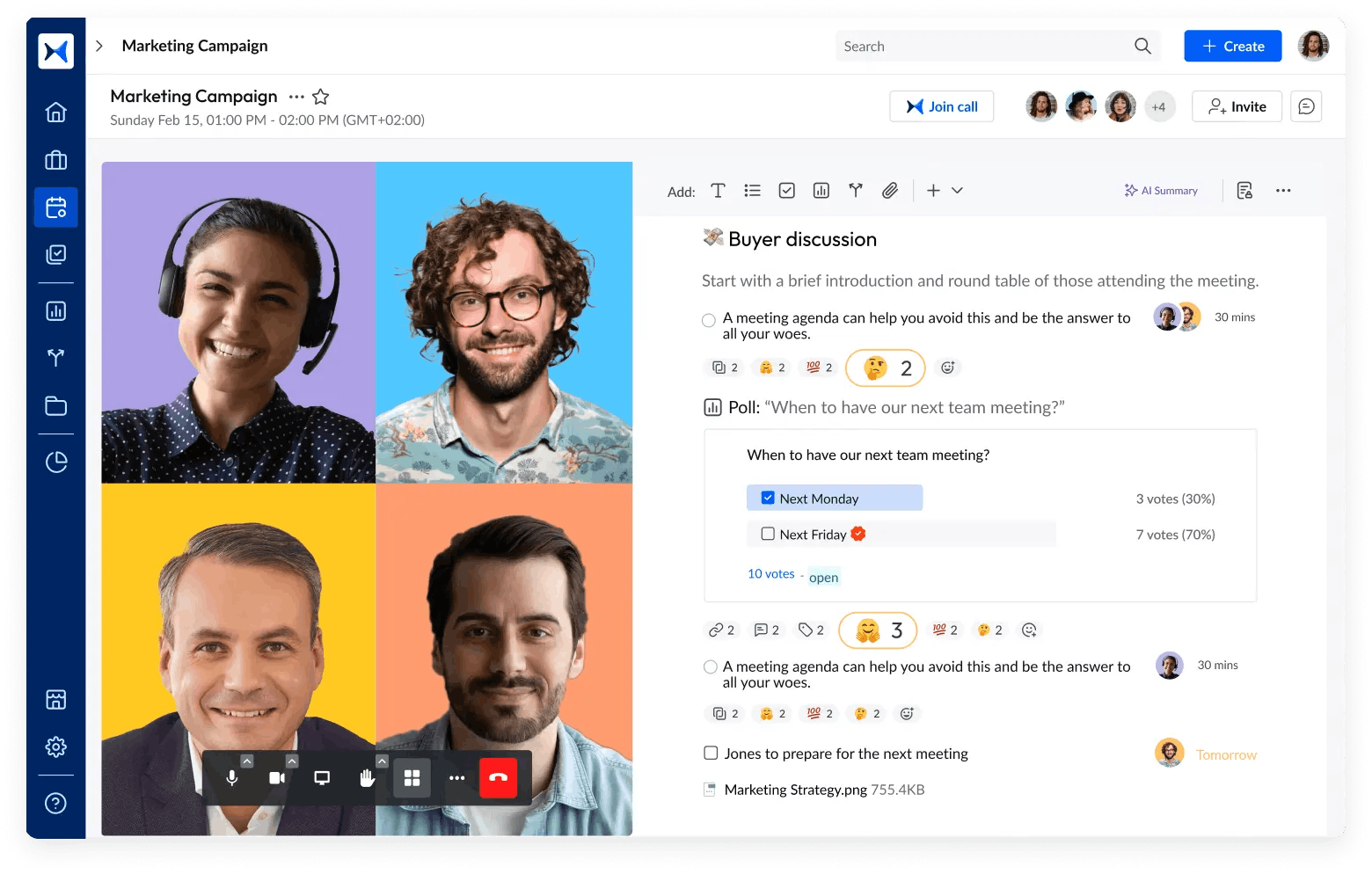
3. Action item management: adam.ai enables the assignment, delegation, and tracking of tasks with detailed information, including priority levels, descriptions, and attachments.
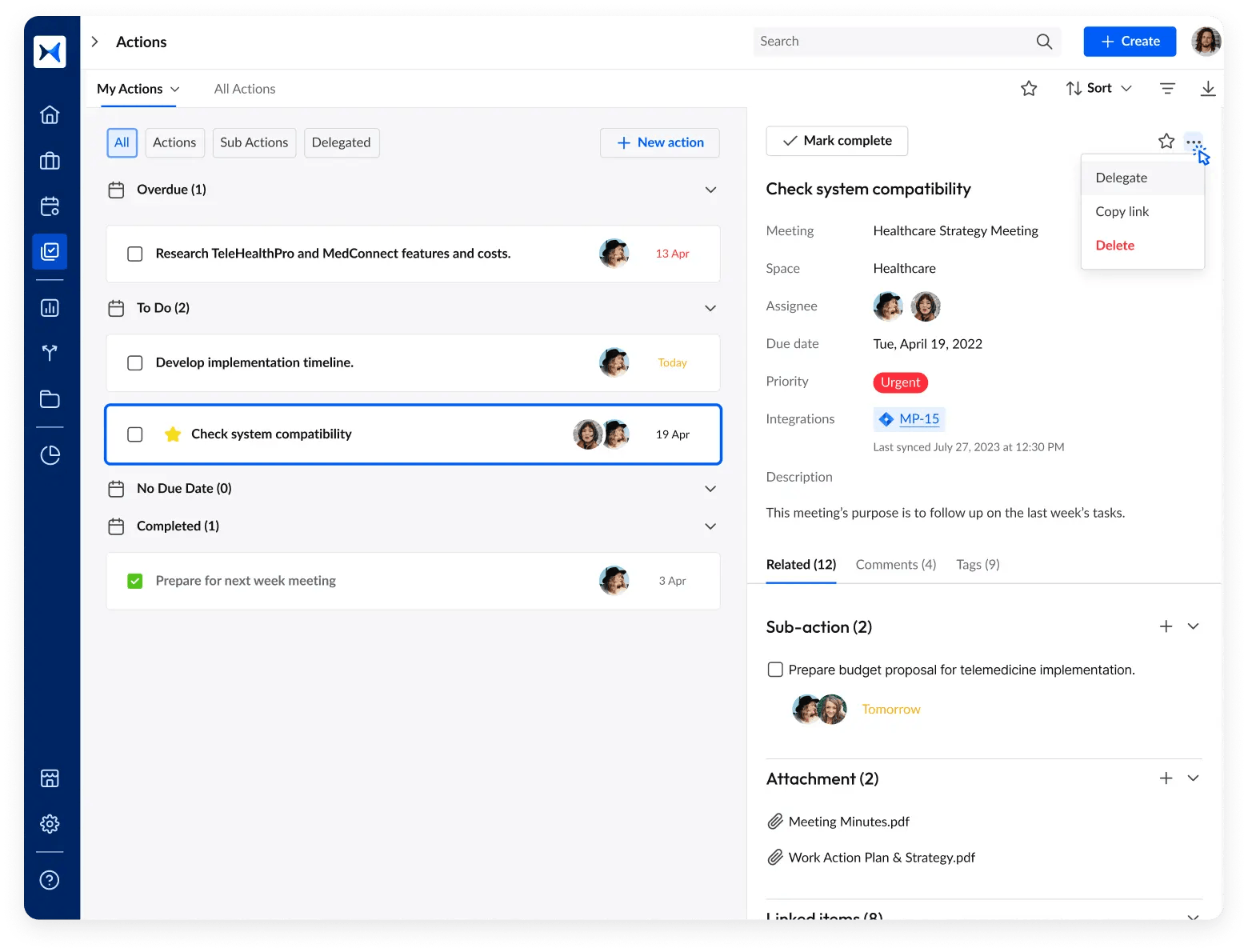
4. Automated meeting minutes The platform allows for the generation, commenting, and sharing of meeting minutes with attendees and stakeholders. It also supports an approval cycle for efficient review and finalization, ensuring accurate documentation of discussions and decisions.
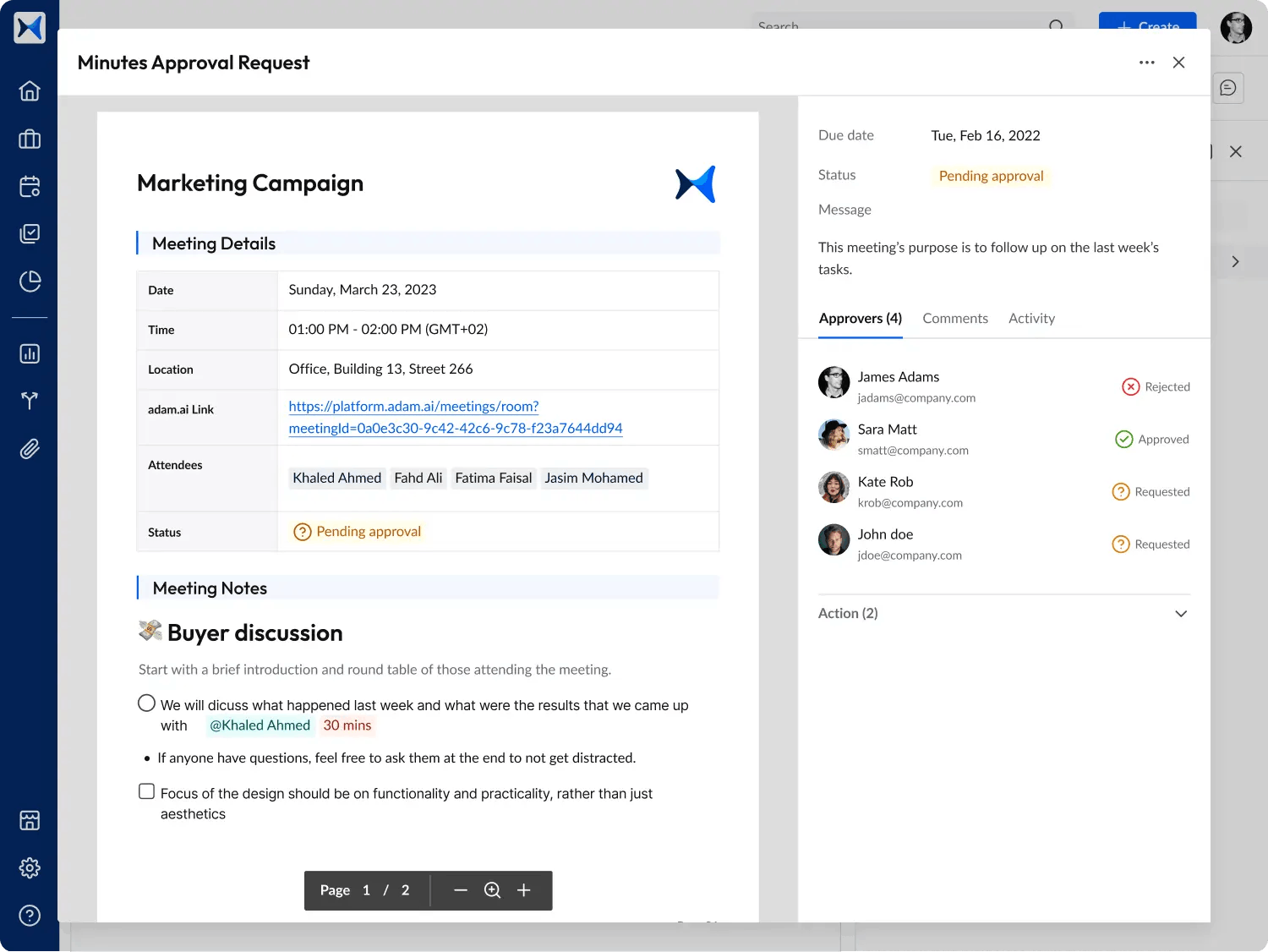
5. Integrated polling and decision-making: adam.ai provides in-meeting polls and voting tools to empower decision-making. It offers dedicated pages to document decisions with their owners in context, facilitating transparent and informed choices.
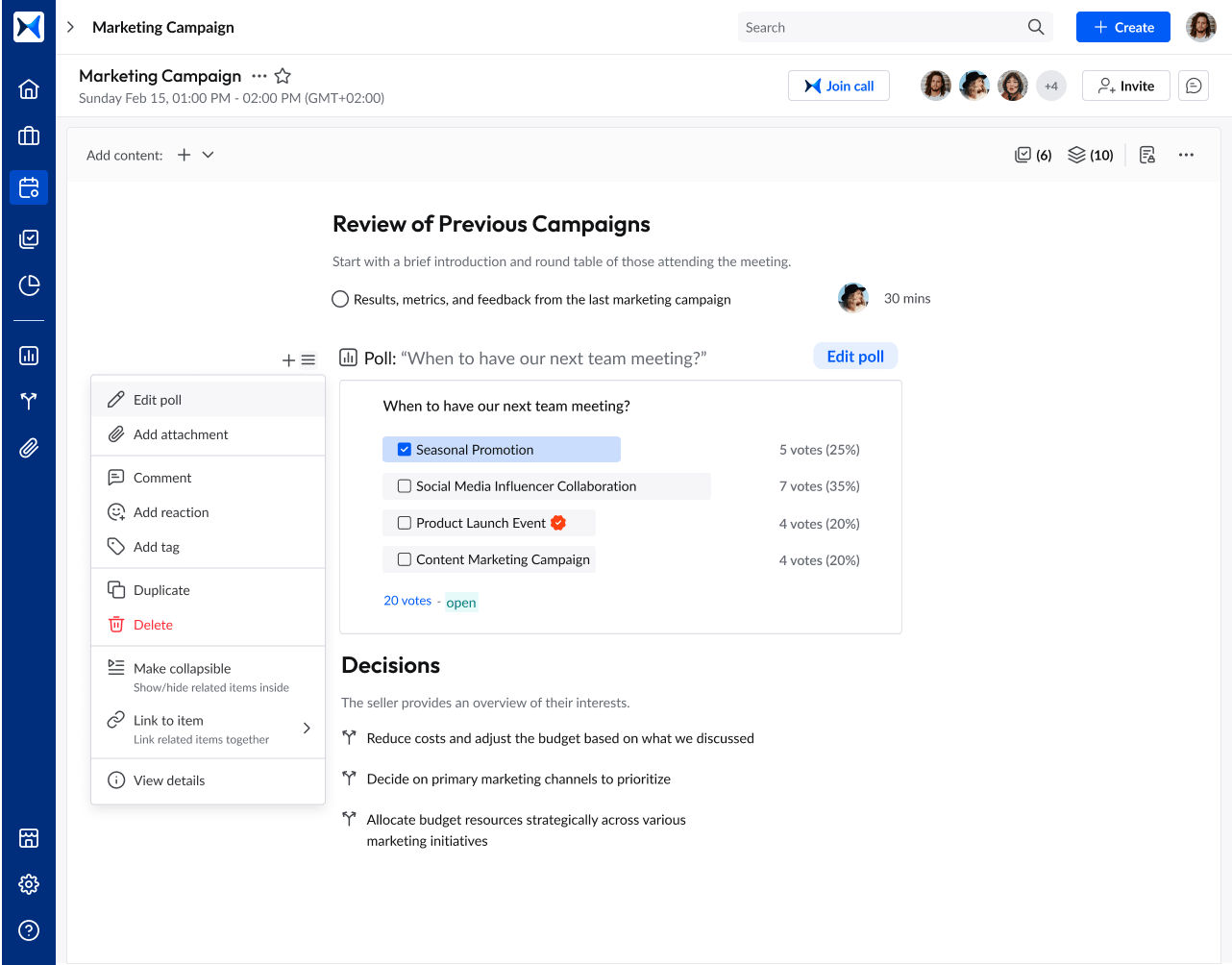
6. Analytical dashboards: The platform features insightful dashboards and reports on meeting outcomes and productivity. These tools simplify the process of monitoring meeting-related data across the enterprise account, enabling data-driven decisions.
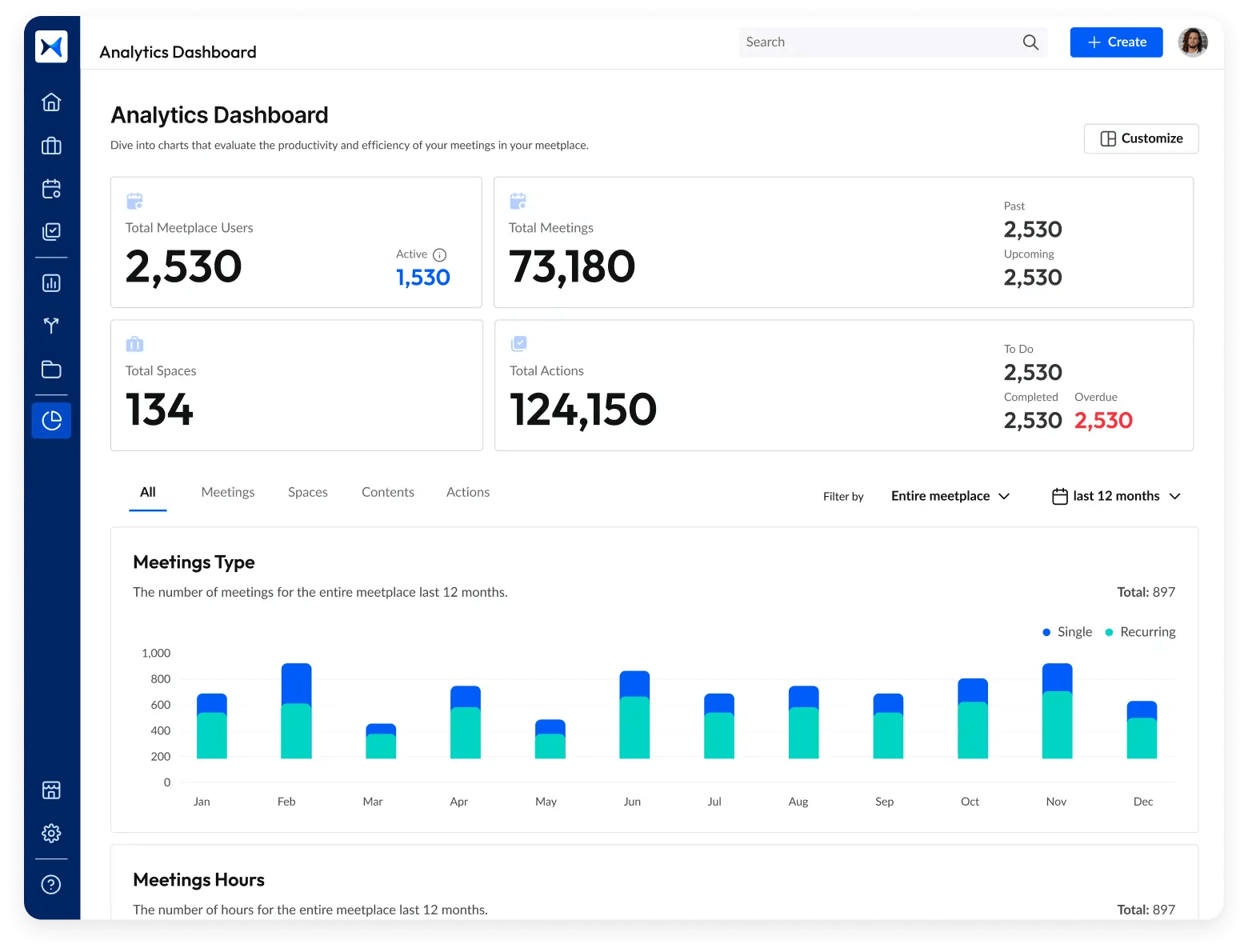
7. Multi-meeting spaces management: adam.ai's multi-space management allows project managers to organize, categorize, and generate insights on meetings and actions related to specific teams or projects. This feature consolidates all meeting affiliations in one place, providing an organized view of relevant meetings, assigned actions, decisions, polls, and attachments.
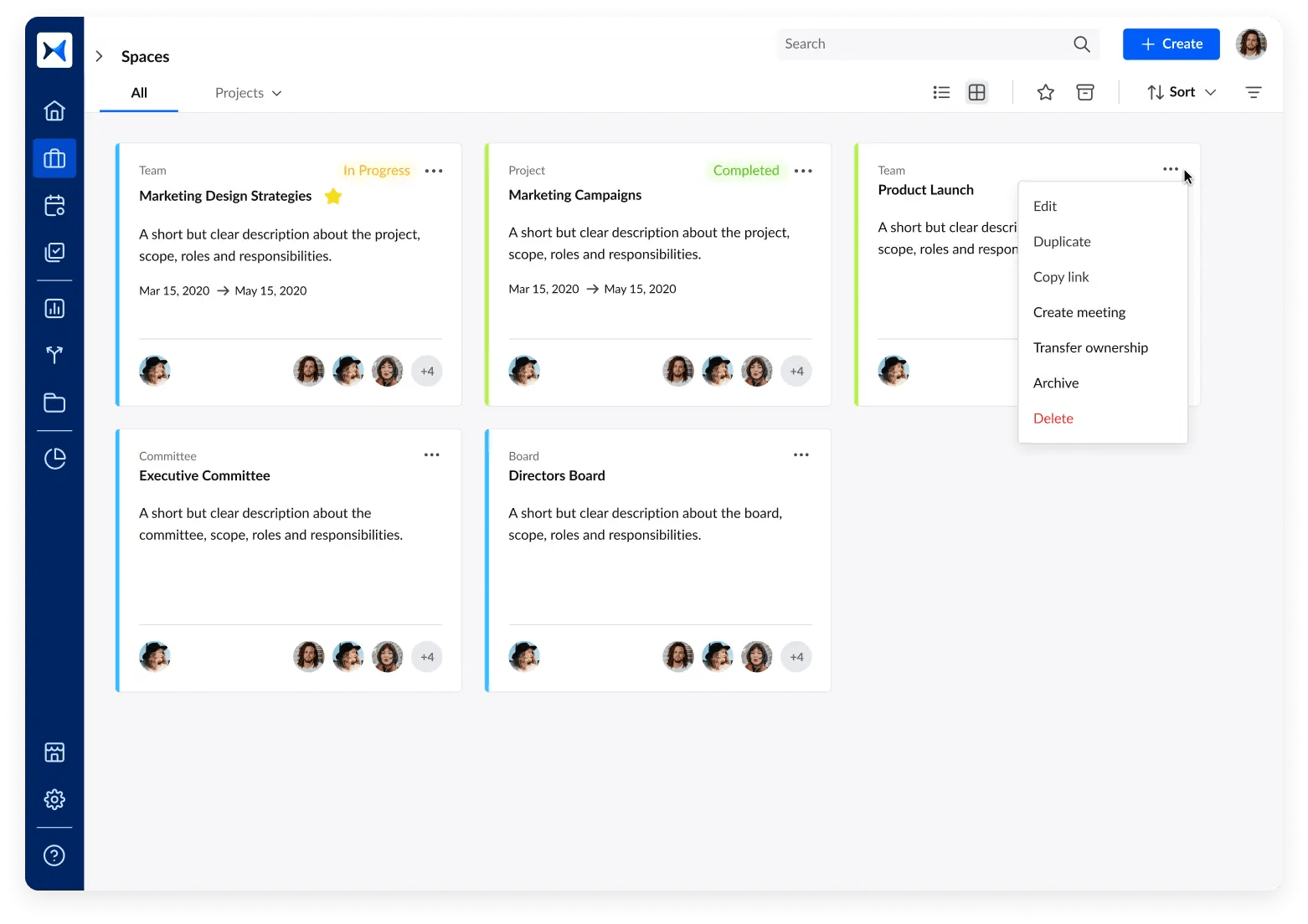
By integrating these features, adam.ai transforms meetings into strategic assets, providing project managers with the tools needed to harness meeting analytics for informed decision-making and improved project performance.
Transform how you conduct critical meetings—From meticulous preparation to effective execution and insightful follow-up, adam.ai integrates comprehensive analytics, full customization, and intuitive interfaces with powerful meeting management tools.
Easy onboarding. Enterprise-grade security. 24/7 dedicated support.
The bottom line
Effective use of meeting data can transform the way project managers make decisions, enabling them to align actions with strategic goals, improve team productivity, and drive measurable results. Leveraging technology for project management isn’t just an advantage; it’s essential in today’s competitive landscape.
And while there may be multiple solutions available, here is why adam.ai is the meeting management software platform you can trust:
- adam.ai is one of Atlassian Ventures' portfolio companies.
- In the meeting management software category on G2, adam.ai has been ranked a leader and a high performer for successive quarters in the past years.
- adam.ai has been included in the Forrester Report in the AI-enabled meeting technology landscape.
- adam.ai is trusted and used by powerful teams and organizations worldwide for all types of critical meetings, like board, committee, project management, and business development meetings.
- And most importantly, adam.ai integrates with your existing workflow, is SOC2 compliant, provides dedicated support and success, and has a free trial option.
Subscribe to adam.ai blog
Stay ahead with the latest insights—get our newest blog posts, tips, and updates sent straight to your inbox.